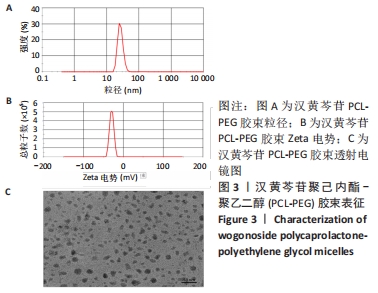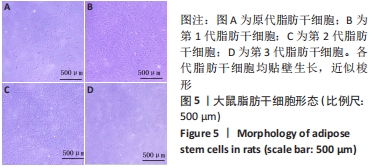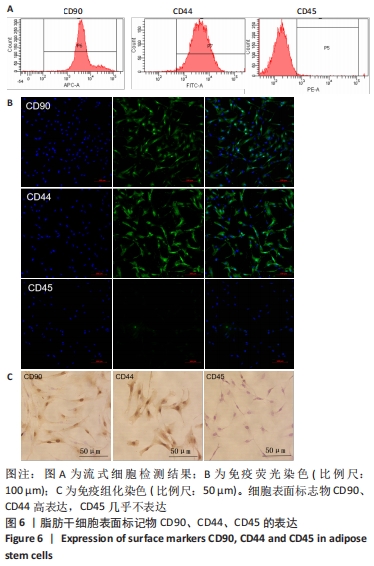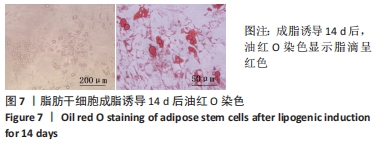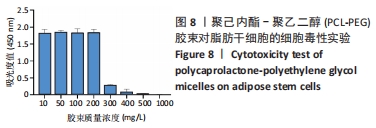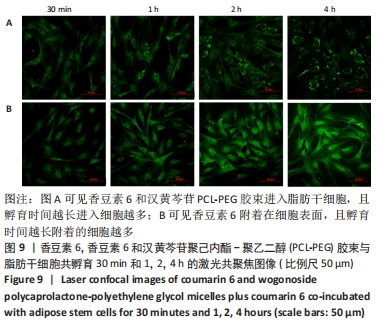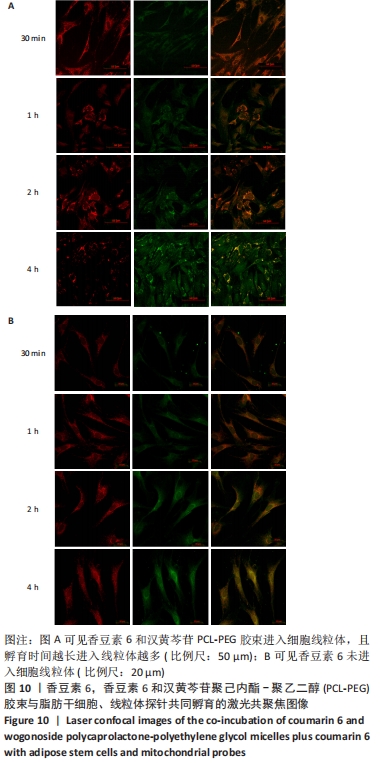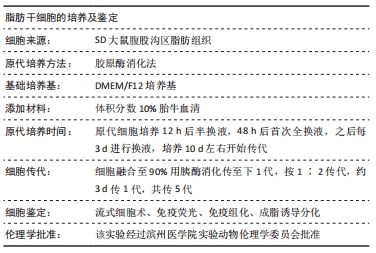中国组织工程研究 ›› 2022, Vol. 26 ›› Issue (31): 4996-5001.doi: 10.12307/2022.780
• 脂肪干细胞 adipose-derived stem cells • 上一篇 下一篇
脂肪干细胞携载汉黄芩苷聚己内酯-聚乙二醇胶束的制备
王 笑1,刘 卿1,胡瑶蕊1,谷成旭1,郭绮萱1,朱永林2,张璐萍1
- 1滨州医学院基础医学院人体解剖学教研室,山东省烟台市 264000;2滨州医学院烟台附属医院骨科,山东省烟台市 264000
Preparation of wogonoside polycaprolactone-polyethylene glycol micelles delivered by adipose stem cells
Wang Xiao1, Liu Qing1, Hu Yaorui1, Gu Chengxu1, Guo Qixuan1, Zhu Yonglin2, Zhang Luping1
- 1Department of Human Anatomy, Basic Medical Sciences, Binzhou Medical University, Yantai 264000, Shandong Province, China; 2Department of Orthopedics, Yantai Affiliated Hospital of Binzhou Medical University, Yantai 264000, Shandong Province, China
摘要:
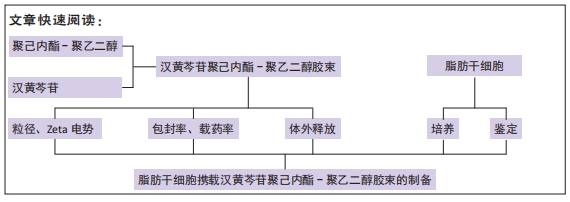
文题释义:
聚己内酯:是一种生物相容性、可生物降解和无毒的热塑性聚酯。
聚乙二醇:是目前应用最广泛的生物相容性高分子化合物之一,是已投入临床使用的各类药物和治疗剂的主要成分。
背景:汉黄芩苷已被证明有抗炎、神经保护等多种药理活性作用,但其半衰期短、难溶于水,有机溶剂溶解后不良反应大。研究发现,聚己内酯-聚乙二醇能够结合高度疏水的药物,解决药物难溶问题且可以达到缓释的效果,但无法精确靶向到达损伤部位,制成胶束后因其尺寸小,可以穿透细胞膜。
目的:制备汉黄芩苷聚己内酯-聚乙二醇胶束以及脂肪干细胞携载汉黄芩苷聚己内酯-聚乙二醇胶束,以解决汉黄芩苷难溶性和半衰期短的问题,并使药物能靶向到达损伤部位。
方法:透析法制备汉黄芩苷聚己内酯-聚乙二醇胶束,对其进行表征,检测包封率和载药量及体外释药速率。采用胶原酶消化法制备SD大鼠脂肪干细胞,流式细胞术、免疫组化、免疫荧光检测CD90、CD44、CD45的表达,成脂诱导14 d后进行油红O染色。CCK-8法检测汉黄芩苷聚己内酯-聚乙二醇胶束对脂肪干细胞的毒性。香豆素6和汉黄芩苷胶束与脂肪干细胞共孵育进行细胞定位。
结果与结论:①汉黄芩苷聚己内酯-聚乙二醇胶束平均粒径为(26.7±0.4) nm,Zeta电势为(-33.2±0.3) mV,外观为比较均一的圆球型;②汉黄芩苷聚己内酯-聚乙二醇胶束包封率为(90.2±2.04)%,载药量为(9.18±0.31)%;③游离汉黄芩苷24 h累计释放率为98%,汉黄芩苷聚己内酯-聚乙二醇胶束96 h累计释放率为87%;④流式细胞术、免疫组化、免疫荧光结果显示,脂肪干细胞表面标志CD90、CD44高表达,CD45几乎不表达,成脂诱导后油红O染色显示脂滴呈红色;⑤CCK-8结果显示,胶束质量浓度在10-200 mg/L时,对脂肪干细胞无毒性;⑥激光共聚焦显微镜观察可见,香豆素6和汉黄芩苷聚己内酯-聚乙二醇胶束能进入脂肪干细胞线粒体;⑦结果表明,汉黄芩苷聚己内酯-聚乙二醇胶束可进入脂肪干细胞内,脂肪干细胞可携载汉黄芩苷聚己内酯-聚乙二醇胶束。
缩略语:聚己内酯-聚乙二醇:polycaprolactone- polyethylene glycol,PCL-PEG
https://orcid.org/0000-0002-9424-5812 (王笑)
中国组织工程研究杂志出版内容重点:干细胞;骨髓干细胞;造血干细胞;脂肪干细胞;肿瘤干细胞;胚胎干细胞;脐带脐血干细胞;干细胞诱导;干细胞分化;组织工程
中图分类号:

